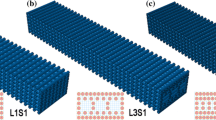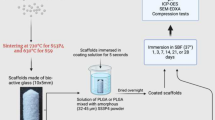Abstract
Injectable bone grafts with strength exceeding that of trabecular bone could improve the clinical management of a number of orthopedic conditions. Ceramic/polymer composites have been investigated as weight-bearing bone grafts, but they are typically weaker than trabecular bone due to poor interfacial bonding. We hypothesized that entrapment of surface-initiated poly(ε-caprolactone) (PCL) chains on 45S5 bioactive glass (BG) particles within an in situ-formed polymer network would enhance the mechanical properties of reactive BG/polymer composites. When the surface-initiated PCL molecular weight exceeded the molecular weight between crosslinks of the network, the compressive strength of the composites increased 6- to 10-fold. The torsional strength of the composites exceeded that of human trabecular bone by a factor of two. When injected into femoral condyle defects in rats, the composites supported new bone formation at 8 weeks. The initial bone-like strength of BG/polymer composites and their ability to remodel in vivo highlight their potential for development as injectable grafts for repair of weight-bearing bone defects.






Similar content being viewed by others
References
T.A. Russell and R.K. Leighton: Comparison of autogenous bone graft and endothermic calcium phosphate cement for defect augmentation in tibial plateau fractures. J. Bone Jt. Surg., Am. Vol. 90A(10), 2057 (2008).
D. Simpson and J.F. Keating: Outcome of tibial plateau fractures managed with calcium phosphate cement. Injury 35(9), 913 (2004).
L. Amendola, A. Gasbarrini, M. Fosco, C.E. Simoes, S. Terzi, F. Delure, and S. Boriani: Fenestrated pedicle screws for cement-augmented purchase in patients with bone softening: A review of 21 cases. J. Orthop. Traumatol. 12(4), 193 (2011).
S. Larsson, V.A. Stadelmann, J. Arnoldi, M. Behrens, B. Hess, P. Procter, M. Murphy, and D.P. Pioletti: Injectable calcium phosphate cement for augmentation around cancellous bone screws. In vivo biomechanical studies. J. Biomech. 45(7), 1156 (2012).
S. Larsson and P. Procter: Optimising implant anchorage (augmentation) during fixation of osteoporotic fractures: Is there a role for bone-graft substitutes?Injury 42, S72 (2011).
J.J. Verlaan, F.C. Oner, and W.J.A. Dhert: Anterior spinal column augmentation with injectable bone cements. Biomaterials 27(3), 290 (2006).
R.Z. Legeros, A. Chohayeb, and A. Schulman: Apatitic calcium phosphates possible dental restorative materials. J. Dent. Res. 61 (SPEC. ISSUE), 343 (1982).
H. Chim and A.K. Gosain: Biomaterials in craniofacial surgery experimental studies and clinical application. J. Craniofac. Surg. 20(1), 29 (2009).
J.A. Hall, M.J. Beuerlein, and M.D. McKee: Open reduction and internal fixation compared with circular fixator application for bicondylar tibial plateau fractures. Surgical technique. J. Bone Jt. Surg., Am. Vol. 91(Suppl 2 Pt 1), 74 (2009).
A.J. Wagoner Johnson and B.A. Herschler: A review of the mechanical behavior of CaP and CaP/polymer composites for applications in bone replacement and repair. Acta Biomater. 7(1), 16 (2011).
M. Bohner: Design of ceramic-based cements and putties for bone graft substitution. Eur. Cell Mater. 20, 1 (2010).
J.E. Dumas, E.M. Prieto, T. Guda, K.J. Zienkiewicz, J. Garza, J. Bible, G.E. Holt, and S.A. Guelcher: Remodeling of settable allograft bone/polymer composites with initial bone-like mechanical properties in rabbit femora. Tissue Eng., Part A 20(1–2), 115–129 (2014).
J.R. Jones: Review of bioactive glass: From Hench to hybrids. Acta Biomater. 9(1), 4457 (2013).
A.R. Boccaccini and J.J. Blaker: Bioactive composite materials for tissue engineering scaffolds. Expert Rev. Med. Devices 2(3), 303 (2005).
L.L. Hench and J. Wilson: Bioceramics. MRS Bull. 16(9), 62 (1991).
P. Saravanapavan, J.R. Jones, R.S. Pryce, and L.L. Hench: Bioactivity of gel-glass powders in the CaO-SiO2 system: A comparison with ternary (CaO-P2O5-SiO2) and quaternary glasses (SiO2-CaO-P2O5-Na2O). J. Biomed. Mater. Res., Part A 66A(1), 110 (2003).
L.L. Hench: The story of bioglass (R). J. Mater. Sci.: Mater. Med. 17(11), 967 (2006).
A. Hoppe, N.S. Gueldal, and A.R. Boccaccini: A review of the biological response to ionic dissolution products from bioactive glasses and glass-ceramics. Biomaterials 32(11), 2757 (2011).
K.E. Tanner: Bioactive composites for bone tissue engineering. Proc. Inst. Mech. Eng., Part H 224(H12), 1359 (2010).
O. Bretcanu, S. Misra, I. Roy, C. Renghini, F. Fiori, A.R. Boccaccini, and V. Salih: In vitro biocompatibility of 45S5 2bioglass (R)-derived glass-ceramic scaffolds coated with poly(3-hydroxybutyrate). J. Tissue Eng. Regener. Med. 3(2), 139 (2009).
M. Bil, J. Ryszkowska, J.A. Roether, O. Bretcanu, and A.R. Boccaccini: Bioactivity of polyurethane-based scaffolds coated with bioglass(R). Biomed. Mater. 2(2), 93 (2007).
J.L. Ryszkowska, M. Auguscik, A. Sheikh, and A.R. Boccaccini: Biodegradable polyurethane composite scaffolds containing bioglass (R) for bone tissue engineering. Compos. Sci. Technol. 70(13), 1894 (2010).
C. Chan, I. Thompson, P. Robinson, J. Wilson, and L. Hench: Evaluation of bioglass/dextran composite as a bone graft substitute. Int. J. Oral Maxillofac. Surg. 31(1), 73 (2002).
R.E. Neuendorf, E. Saiz, A.P. Tomsia, and R.O. Ritchie: Adhesion between biodegradable polymers and hydroxyapatite: Relevance to synthetic bone-like materials and tissue engineering scaffolds. Acta Biomater. 4, 1288 (2008).
G. Jiang, M.E. Evans, I.A. Jones, C.D. Rudd, C.A. Scotchford, and G.S. Walker: Preparation of poly(epsilon-caprolactone)/continuous bioglass fibre composite using monomer transfer moulding for bone implant. Biomaterials 26(15), 2281 (2005).
G. Jiang, G.S. Walker, I.A. Jones, and C.D. Rudd: XPS identification of surface-initiated polymerisation during monomer transfer moulding of poly(epsilon-caprolactone)/bioglass (R) fibre composite. Appl. Surf. Sci. 252(5), 1854 (2005).
E. Verne, C. Vitale-Brovarone, E. Bui, C.L. Bianchi, and A.R. Boccaccini: Surface functionalization of bioactive glasses. J. Biomed. Mater. Res., Part A 90A(4), 981 (2009).
C. Kunze, T. Freier, E. Helwig, B. Sandner, D. Reif, A. Wutzler, and H.J. Radusch: Surface modification of tricalcium phosphate for improvement of the interfacial compatibility with biodegradable polymers. Biomaterials 24(6), 967 (2003).
M. Barsbay, G. Gueven, M.H. Stenzel, T.P. Davis, C. Barner-Kowollik, and L. Barner: Verification of controlled grafting of styrene from cellulose via radiation-induced RAFT polymerization. Macromolecules 40(20), 7140 (2007).
S.A. Guelcher, V. Patel, K.M. Gallagher, S. Connolly, J.E. Didier, J.S. Doctor, and J.O. Hollinger: Synthesis and in vitro biocompatibility of injectable polyurethane foam scaffolds. Tissue Eng. 12(5), 1247 (2006).
N.S. Ruppender, A.R. Merkel, T.J. Martin, G.R. Mundy, J.A. Sterling, and S.A. Guelcher: Matrix rigidity induces osteolytic gene expression of metastatic breast cancer cells. PLoS One 5(11), e15451 (2010).
K.B. Garnier, R. Dumas, C. Rumelhart, and M.E. Arlot: Mechanical characterization in shear of human femoral cancellous bone: Torsion and shear tests. Med. Eng. Phys. 21(9), 641 (1999).
C.M. Ford and T.M. Keaveny: The dependence of shear failure properties of trabecular bone on apparent density and trabecular orientation. J. Biomech. 29(10), 1309 (1996).
A.E. Hafeman, K.J. Zienkiewicz, A.L. Zachman, H-J. Sung, L.B. Nanney, J.M. Davidson, and S.A. Guelcher: Characterization of the degradation mechanisms of lysine-derived aliphatic poly(ester urethane) scaffolds. Biomaterials 32(2), 419 (2011).
Z. Wang, B. Lu, L. Chen, and J. Chang: Evaluation of an osteostimulative putty in the sheep spine. J. Mater. Sci.: Mater. Med. 22(1), 185 (2011).
R.A. Khan, A.J. Parsons, I.A. Jones, G.S. Walker, and C.D. Rudd: Effectiveness of 3-aminopropyl-triethoxy-silane as a coupling agent for phosphate glass fiber-reinforced poly(caprolactone)-based composites for fracture fixation devices. J. Thermoplast. Compos. Mater. 24, 517 (2011).
G. Oertel: Polyurethane Handbook, 2nd ed. (Hanser Gardner Publications, Munich, Germany, 1994).
H.R. Brown and T.P. Russell: Entanglements at polymer surfaces and interfaces. Macromolecules 29(2), 798 (1996).
A. Gurarslan, J. Shen, and A.E. Tonelli: Behavior of poly(epsilon-caprolactone)s (PCLs) coalesced from their stoichiometric urea inclusion compounds and their use as nucleants for crystallizing PCL melts: Dependence on PCL molecular weights. Macromolecules 45(6), 2835 (2012).
M.R. Allen, H.A. Hogan, W.A. Hobbs, A.S. Koivuniemi, M.C. Koivuniemi, and D.B. Burr: Raloxifene enhances material-level mechanical properties of femoral cortical and trabecular bone. Endocrinology 148(8), 3908 (2007).
M. Libicher, J. Hillmeier, U. Liegibel, U. Sommer, W. Pyerin, M. Vetter, H.P. Meinzer, I. Grafe, P. Meeder, G. Noldge, P. Nawroth, and C. Kasperk: Osseous integration of calcium phosphate in osteoporotic vertebral fractures after kyphoplasty: Initial results from a clinical and experimental pilot study. Osteoporosis Int. 17(8), 1208 (2006).
G. Maestretti, C. Cremer, P. Otten, and R.P. Jakob: Prospective study of standalone balloon kyphoplasty with calcium phosphate cement augmentation in traumatic fractures. Eur. Spine J. 16(5), 601 (2007).
J. Dumas, E. Prieto, K. Zienkiewicz, T. Guda, J. Wenke, J. Bible, G. Holt, and S. Guelcher: Remodeling of settable allograft bone/polymer composites with initial bone-like mechanical properties in rabbit femora. Tissue Eng., Part A 20(1–2), 115 (2014).
J.M. Page, E.M. Prieto, J.E. Dumas, K.J. Zienkiewicz, J.C. Wenke, P. Brown-Baer, and S.A. Guelcher: Biocompatibility and chemical reaction kinetics of injectable, settable polyurethane/allograft bone biocomposites. Acta Biomater. 8(12), 4405 (2012).
K. Gorna and S. Gogolewski: Preparation, degradation, and calcification of biodegradable polyurethane foams for bone graft substitutes. J. Biomed. Mater. Res. 67A, 813 (2003).
S. Gogolewski and K. Gorna: Biodegradable polyurethane cancellous bone graft substitutes in the treatment of iliac crest defects. J. Biomed. Mater. Res. 80A, 94 (2007).
T.J. Lehtonen, J.U. Tuominen, and E. Hiekkanen: Resorbable composites with bioresorbable glass fibers for load-bearing applications. In vitro degradation and degradation mechanism. Acta Biomater. 9(1), 4868 (2013).
S. Midha, W. van den Bergh, T.B. Kim, P.D. Lee, J.R. Jones, and C.A. Mitchell: Bioactive glass foam scaffolds are remodelled by osteoclasts and support the formation of mineralized matrix and vascular networks in vitro. Adv. Healthc. Mater. 2(3), 490 (2013).
ACKNOWLEDGMENTS
This material is based upon work supported by the National Science Foundation under (Grant No. 0847711) (CAREER award to S.A. Guelcher) and the National Institutes of Health through the National Institute of Arthritis and Musculoskeletal and Skin Diseases under Award Number AR064304 (S.A. Guelcher and J. C. Wenke). The content is solely the responsibility of the authors and does not necessarily represent the official views of the National Institutes of Health. A.J. Harmata acknowledges financial support from an Oak Ridge Institute for Science and Education Fellowship funded by the U.S. Army Medical Research and Materiel Command.
Author information
Authors and Affiliations
Corresponding author
Additional information
This paper has been selected as an Invited Feature Paper.
Disclosure
S.A. Guelcher is a consultant for Medtronic, Inc. Medtronic supplied some of the raw materials used to fabricate the composites and has supported research in Guelcher’s laboratory at Vanderbilt University.
Rights and permissions
About this article
Cite this article
Harmata, A.J., Ward, C.L., Zienkiewicz, K.J. et al. Investigating the effects of surface-initiated polymerization of ε-caprolactone to bioactive glass particles on the mechanical properties of settable polymer/ceramic composites. Journal of Materials Research 29, 2398–2407 (2014). https://doi.org/10.1557/jmr.2014.254
Received:
Accepted:
Published:
Issue Date:
DOI: https://doi.org/10.1557/jmr.2014.254




